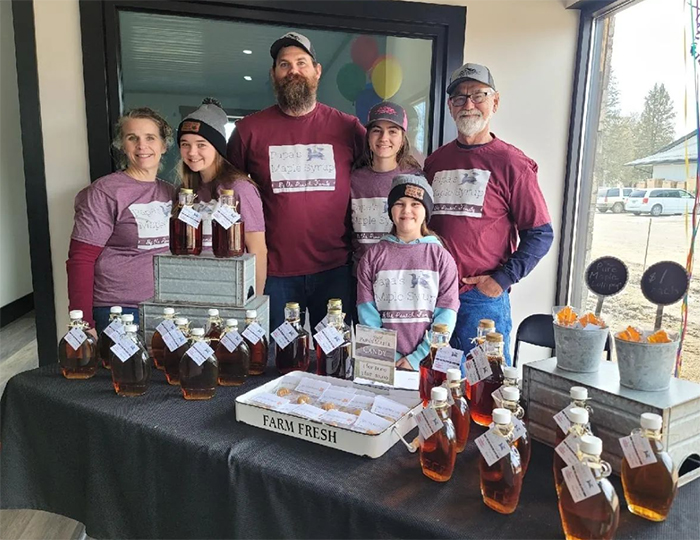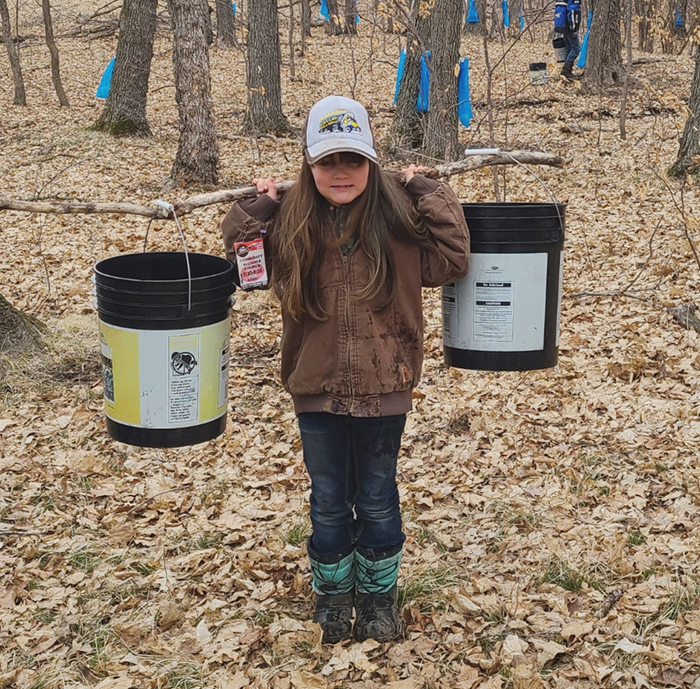Maple syrup is a tradition for Pausch family
News | Published on April 19, 2022 at 4:44pm EDT | Author: Chad Koenen
0Vergas family turns local sap into maple syrup

Amber, Caleigh, Jamie, Claire, Carley and Dennis Pausch display their maple syrup goods during the open house at Summers Construction Design Center in Vergas during the weekend of the Maple Syrup Festival.
By Robert Williams
Editor
Dennis Pausch is the patriarch of a Vergas family that is synonymous with maple syrup production and a distinct collection of products. The history of that production goes back generations. ¶ The family has been making maple syrup, and more recently candies and lollipops, since 1964, but the process was handed down by earlier generations dating back to the settlement days of Vergas. ¶ Pausch’s first recollection of tapping maple trees goes back to the 1960’s when handmade sumac sprouts were used in tapping, before a move to aluminum and the now plastic. It was a learning experience in the beginning.
¶ “We had some maples on the property and started cooking,” he said. “One of the first years that I can remember, my dad tapped some trees and brought some sap and started boiling it in the house. After about the third day the wallpaper fell off the walls.”
Sap is boiled down at a ratio of 40-to-1. For example, to make one gallon of syrup one must get rid of 39 gallons of steam onto the walls or somewhere.
“He was not allowed to do that again,” Pausch laughed.

It was common in the 1960’s and before to use cast iron pots. Sap would burn on the side and create a dark syrup.
“We used what we could at the time,” he said.
Later, the family used a flat pan, six-feet wide, that fit on top of a stock tank, which allowed for a fire in the tank to evaporate the sap. Large fuel barrels were also used.
Current systems have evolved to include using reverse osmosis for purification purposes and preheaters to help evaporate faster.
While equipment has definitely changed over the years, the process is relatively the same.
“It hasn’t changed much. You’re still doing exactly the same thing that the Native Americans did. You get rid of the moisture.”
Dennis Pausch
The Pausch family uses a wood-fired pan with dividers that allows continual heat as the sap enters one end of the 10-foot long pan and travels through the pan’s dividers. The liquid evaporates along the way under exhaust hoods that vent steam to ultimately become syrup at the other end of the pan.
This system has been in place for the past five years and can boil off an amazing 60 gallons per hour.
So far, the weather has hampered production. Mother Nature needs to produce specific conditions to make for ideal harvests.
“We’ve only cooked once,” said Pausch. “A season will run anywhere from February to May. The earlier your season starts the better chance you have. We’ve collected twice and cooked once. As the season gets later into April, the chance of it just warming up and then they’ll be done.”
The key to running sap is it has to freeze at night and then get warm during the day. Those conditions can also allow for sap to run in the fall, according to Pausch.
“You never know. If it’s 40 degrees and the sun is shining, it’ll probably run real good. If it’s 45, cloudy and the wind is blowing it might not run. Sunshine is big. The trees do feel the effect of wind and it will make a difference on the trees.
Dennis Pausch
“It’s a lot like farming,” he continued. “You go out and put your taps in, in the spring, you don’t know what kind of crop you’re going to get.”
A short season is not all bad. It’s all about watching the sap and the conditions.
“We’re hoping we’re going to have some good weather yet,” said Pausch. “Last year, the season was really short also, but we had some days when it really ran good.”
The Pausch’s had only four or five collections in 2021, but got maximum production from the trees.
“We had a really good year because when the trees ran they really, really ran,” he said.
Freezing temperatures are critical.
“When it gets up to 50 degrees and doesn’t freeze at night the trees are done,” said Pausch. “It has to freeze.”
When the work needs to get done it takes the help of the entire Pausch family. Dennis has been training in the next generation of helpers after he had twin grandsons recently leave for college.
“They were a really good crew, but now their sisters and brother have taken over the brunt of the work. You have to have good help and everybody gets into it,” he said.
Passing on the family knowledge to the kids is important. Sometimes it takes a while for them to appreciate the effort it takes to make the syrup.
“Some of them like it. Some of them, it’s a little too much work,” he said. “Most of them really enjoy it. They drill the holes, collect the sap and cook it. For some of them, it’s really become part of what they do.”
There is also a habit-forming element to working with sap.
“It’s a strange thing, but once you are in a sap sack and you get the steam in your system it’s worse than heroin. It’s so addictive. Why would anybody go out in the woods, stumble through the brush and carry heavy buckets? And they do it every year. It’s got to be an addictive thing. It is fascinating.”
Dennis Pausch
It is also relative to the area as Otter Tail County sits on the very western edge of the maple forest in the United States.
“If you go west of Otter Tail County it’s rare to find a maple tree,” Pausch said.
Maple trees make this area part of the great mystery that is sap and syrup. A number of legends exist on its initial discovery.
Pausch related a legend about it starting from a randomly placed hatchet.
“Legend has it that a Native American came home from hunting and just whacked his hatchet into a maple tree and forgot about it. The next day his wife was going to cook something and noticed something like water in a pot underneath the hatchet. Rather than go down to the river to get water for cooking, she used what was in the pot and it was really sweet. That’s how they figured out maple syrup.”
Despite working with maple trees for half a century, the magic of the process is not lost on Dennis.
“Who, but God, could figure out that you take a maple tree and drill a hole in it and you get something like maple syrup?” he said. “Incredible.”
The family’s goods are sold under the brand name Papa’s Maple Syrup and can be purchased directly from the family, at Otter Coffee and Ice Cream and Vergas Hardware in Vergas. Around the region, they can also be purchased at Lakes Processing in Detroit Lakes and Heart O’ Lakes Quality Meats in Pelican Rapids.
Find out more on Facebook at facebook.com/papasmaplesyrup

